Apple 15-inch MacBook Pro (Late 2011) Review
by Anand Lal Shimpi on November 17, 2011 5:10 PM EST- Posted in
- Mac
- Apple
- Intel
- MacBook Pro
- Sandy Bridge
- Laptops
Display Quality
The display hasn't changed since earlier this year, although this is the first 15-inch 2011 MacBook Pro that I've tested with the standard resolution (1440 x 900), glossy panel. Aesthetically I prefer this panel (I'm the rare case that isn't bothered by gloss) and the lower resolution is easier on my eyes, but for productivity I do feel the 1680 x 1050 upgrade is worth it. If this is going to be a workhorse, and you have good eyesight, get the high-res version.
As always, Apple calibrates its panels at the factory. Note the out-of-the-box white point across the 11-inch MacBook Air, 13-inch MacBook Air and 15-inch MacBook Pro:
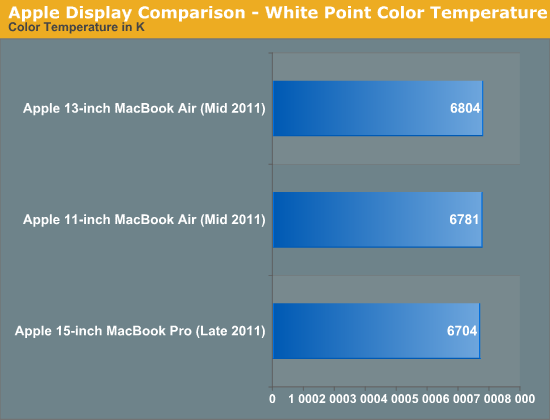
Apple wants to deliver as consistent of an experience as possible across its product line. While the Air models still don't have quite as high quality a panel as the Pro, at least there aren't any wide variations in what constitutes white on these panels.
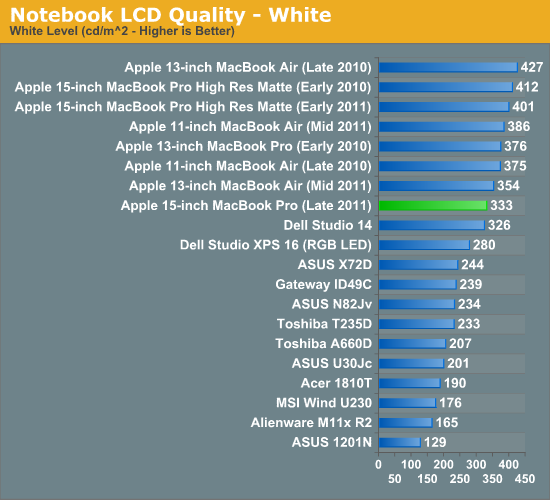
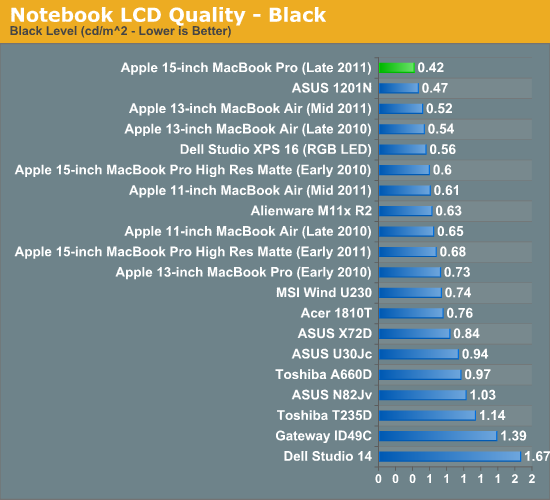
Brightness is down a bit compared to the high-res panel we looked at earlier this year, but so are black levels. The combination of the two actually results in a slightly higher contrast ratio than what we measured on the early 2011 models. In practice the panel looks just as good and seems to get just as blindingly bright as my personal 15-inch.
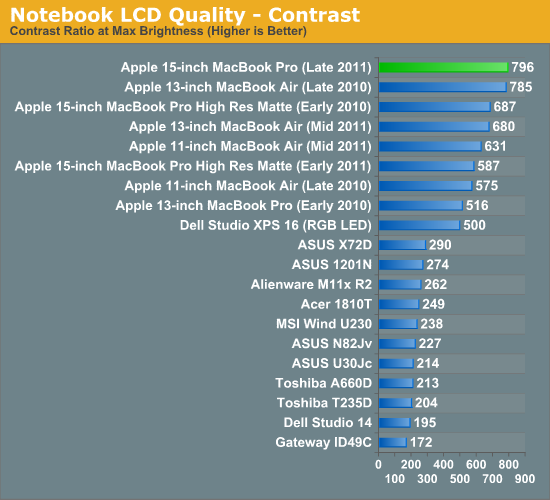
Color quality and gamut are virtually identical as well, no surprises here:
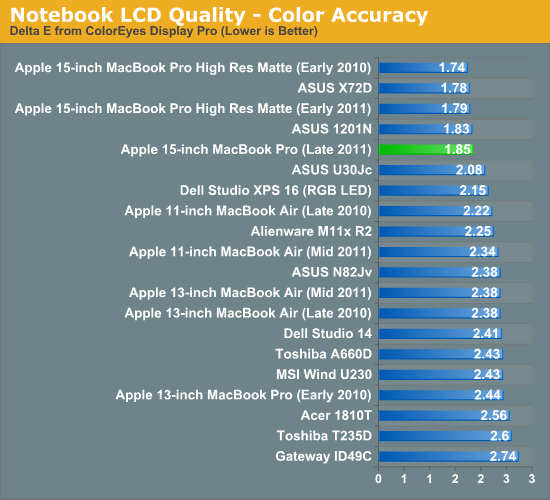

Hard Drive
The more traditional Macs (MBP, Mac Pro, iMac) continue to ship with mechanical hard drives by default, the late 2011 update is no different. My review sample came with a 5400RPM Toshiba MK5064GSXF. The drive features two 320GB platters (obviously not all in use for the 500GB capacity), and an 8MB cache.
All of my personal systems use SSDs and in testing the new MBP with a hard drive I can only say that the move back is more painful than ever. It's most noticeable when multitasking. Installing applications while browsing the web and copying files just seems to slow to a crawl compared to my SSD equipped MacBook Pro. If you're going to buy any new machine, especially if you're paying top dollar for something you expect to feel fast, you definitely need an SSD.

The good news is Apple's SSD pricing isn't horribly unreasonable, at least at the beginning. For $200 you can upgrade the 15-inch MacBook Pro to a 128GB drive (most likely a 3Gbps Samsung based SSD). It's when you look at the 256GB or larger drives that you're probably better off buying your own. You can buy a 256GB Crucial m4 for under $400 today, and a 240GB Vertex 3 will set you back around $460. Both options are cheaper (and faster) than Apple's $600 256GB upgrade. If you get the high-end 15-inch MBP model however, the upgrade prices drop by $100 - making the Apple route much more cost competitive. You don't get the same performance you would from an aftermarket drive, but with less headaches and potential for issues it's possibly a better route.
The 512GB drives are most definitely not a bargain from Apple. To equip a 15-inch MBP with a 512GB SSD, Apple wants $1200. You're much better off buying a 512GB Samsung SSD 830 for under $800 and pocketing the difference.
| Apple SSD Upgrade Pricing | |||||
| 128GB | 256GB | 512GB | |||
| 13-inch 2011 MacBook Pro | $200 | $600 | $1200 | ||
| 13-inch 2011 MacBook Pro (high end) | $100 | $500 | $1100 | ||
| 15-inch 2011 MacBook Pro | $200 | $600 | $1200 | ||
| 15-inch 2011 MacBook Pro (high end) | $100 | $500 | $1100 | ||
| 17-inch 2011 MacBook Pro | $100 | $500 | $1100 | ||
What aftermarket SSD should you buy? If you want to play it safe and hang on to TRIM support, go with Apple. Ever since I've been reviewed SSDs however I've run aftermarket SSDs in my Macs, mostly without any major issues. I can vouch for the Intel SSD 510, Samsung SSD 830 and OCZ Vertex 3. At one point or another I've used all of them in my 2011 MacBook Pro. My current setup is a Samsung 830 in the primary drive bay and an Intel SSD 510 in place of my optical drive, the combination works wonderfully.
Still Great WiFi
Apple continues to quietly focus on delivering excellent WiFi performance with the MacBook Pro. In the late 2011 models WiFi is still powered by Broadcom's BCM4331 3x3 solution. A quick test with a 3rd generation Time Capsule showed us peak transfer rates of 154Mbps, in line with what we've seen with the first generation Sandy Bridge MacBook Pro.

Despite Apple's move to Bluetooth 4.0 support on some of its other platforms, the MacBook Pro remains at 2.1 with the same BCM2070 controller.
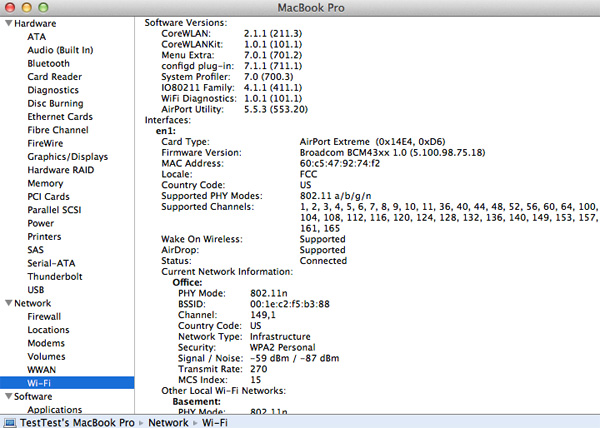


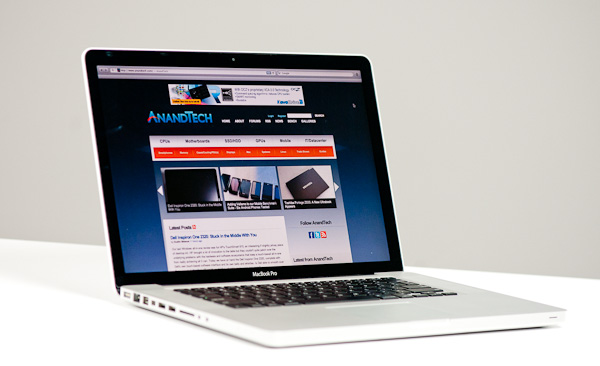








101 Comments
View All Comments
ananduser - Sunday, November 20, 2011 - link
OpenGL drivers are also better and actually up to date compared to OSX, you keep to omit that.Back in 2011(your link is a test from 2008) there are Win7 ultrabooks(that come to mind) that offer at least comparable battery life with the most recent Air. Anand should use desktop Flash browsing in his browsing tests so as to provide more realistic battery life patterns.
KoolAidMan1 - Sunday, November 20, 2011 - link
Are you really being this nitpicky? When I talk about video drivers being more up to date in Windows, I figure that both DX and OpenGL can be inferred. The only reason I wasn't as specific is because nothing (not even Carmack's RAGE) uses OpenGL in Windows these days. I didn't think it was even worth mentioning given that DirectX is the standard, so much so that even he threw in the towel.If you can't infer that then maybe I need to spell everything out for you from now on. Either way it doesn't change my core criticisms that video drivers from GPU manufacturers are more up to date than the ones that Apple puts out much less frequently on their own.
As for recent Win7 ultrabooks, I expect that the battery life results would be similar with the same hardware as the Air given that Windows 7 and Vista are still roughly in line with each other. Win7 is actually marginally worse in terms of battery life if I'm not mistaken.
Either way, the test is from 2008 but I don't expect the results to be any different on similar hardware given that Win7 hasn't yielded any improvements in that area.
Regarding tests with and without Flash, he's always very clear when he's having it off or on. In the case of the 2008 test it wasn't mentioned, so I have to assume that Flash was used in both tests.
You seem to be desperately looking for excuses.
ananduser - Sunday, November 20, 2011 - link
I was under the malevolent influence of your nick :).The Verge's and Engadget's recent ultrabook reviews yielded similar battery life across the board. One exception is that of Sammy's Series 9, but that is a significantly older part. Toshiba's Protege actually has the highest battery life out of the pack(Air included). So NO, things have changed since 2008, and your axiom is wrong.
Why would I care so much to look for excuses ?
Death666Angel - Friday, November 18, 2011 - link
"it would have to wait until Haswell, where integrated graphics performance is supposed to be much better."I still hope that AMD can deliver good CPU performance within the next year or two. Do you think Apple will ever bother with AMD, even if they become competitive again?
Vepsa - Friday, November 18, 2011 - link
I really want one of these. However, I want to know what you guys do with your review machines too. If you don't have to send this one back, I'll take it ;)TheGeoff - Friday, November 18, 2011 - link
Cool. Glad to hear they addressed that.MobiusStrip - Friday, November 18, 2011 - link
At least you can now GET the matte screen on the 15" (for an extra $150, or $50 more than the optional higher-res screen), although it's still inexplicably not available on the machines that are most likely to leave the house: the 13" MBP and the Airs.After many, many hours working with matte and glossy screens under all lighting conditions, you'll realize: glossy screens suck. This asinine fad is the biggest regression in computing since... what?
It's time that reviews call this out instead of and make it a marketing liability that Apple and others can't ignore, instead of (yes, here it comes) GLOSSING OVER IT.
tzhu07 - Monday, November 21, 2011 - link
Yes, totally. I don't understand the glossy trend. When I was in the market for a 2560 monitor, I had to immediately eliminate the Apple 27" display because of the glossy screen. They lost $1,000 from a customer by default.NEC ended up with my money for the PA271W.
MadMacMan - Friday, November 18, 2011 - link
Wait for Haswell? What the hell? You might as well never get any notebook or computer of any kind for that matter, as something better is always on the horizon. Even Ivy Bridge is 6-8 months too far into the future as far as I'm concerned.I just discovered this site and spent four hours reading reviews and benchies last night. lol...It works so well for me because Anand thinks like me when it comes to wanting your cake and eating it, too, with using a 15" or 17" MacBook Pro along with a 27" ThunderBolt / (LED) Cinema Display. Right down to using the Magic Trackpad instead of a mouse. haha...that's awesome!
Well, this setup has really only been possible on a more serious level since Sandy Bridge and ThunderBolt. It is about to get even sweeter once there are ThunderBolt adapters and devices coming out, such as the Sonnet TB --> ExpressCard/34 adapter and PCIe expansion enclosures that will allow multiple full-length PCIe cards to be added to a *laptop*, something that still requires a Mac Pro today.
Finally, I actually wanted to add something to this review that wasn't mentioned and that has been a thorn in my eye with the 2011 (Early as well as Late). The 15" and 17" MBP's SATA III implementation STILL doesn't work in the optical drive bay! I have two OWC Mercury EXTREME Pro SATA III (6Gbps) SSD's that I used to get upwards of 900MB/s (and over 100,000 IOPS) in a Mac mini server before I switched (back) to this (laptop+display) model. Even more infuriating is the fact that the 13" MBP works just fine with SATA III SSD's in *both* bays! Grrr! Yes, I realize that Apple not only didn't advertise the fact that SATA III drives can be used since its Early-2011 MBP models, but they haven't even so much as mentioned it in any of its marketing materials. Whatever...I'm back down to 550MB/s using just one of my solid state drives. (P.S.: Yes, I know, first world problem...)
umesh - Saturday, November 19, 2011 - link
Has anyone noticed that the second table above reads "Apple 15-inch Late 2011 MacBook Pro CPU Comparison", whereas the listed processors all belong to the EARLY 2011 MBP models?